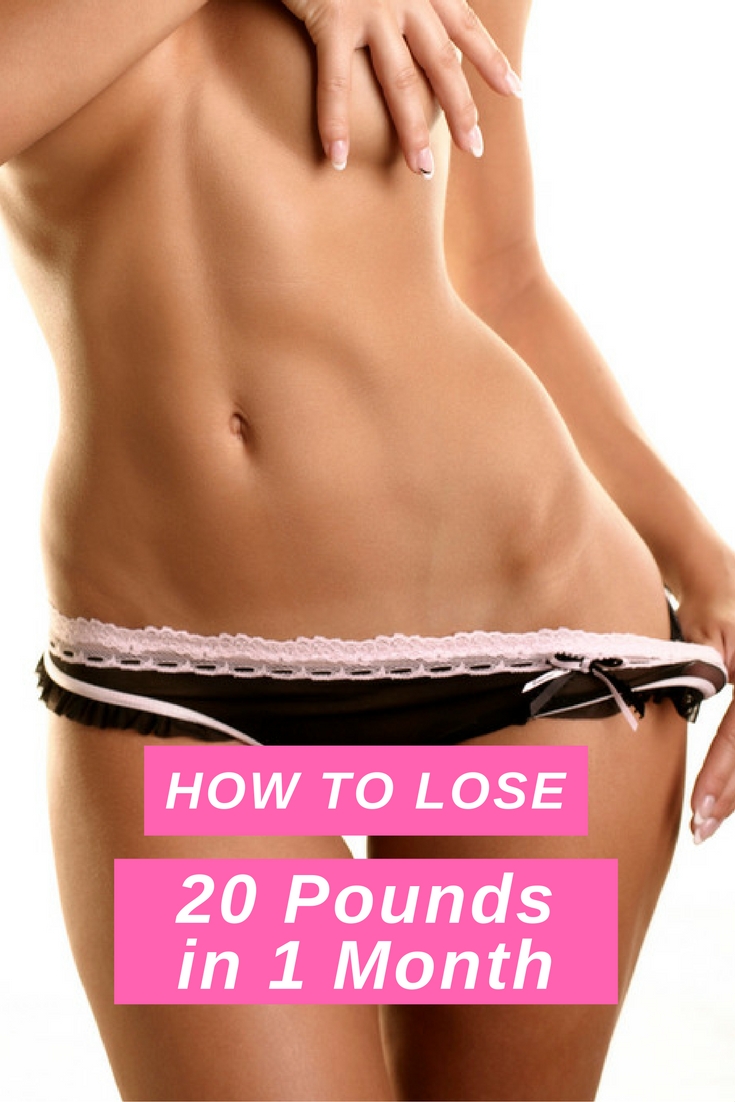How to Lose 20 Pounds in a Month

Article Summary
1. Eating at Least 2 Raw Fruits and/or Vegetables Before Every Meal

· Example: Eating 2 carrots, an apple and a stick of celery or any fruit and vegetable combination will help you lose weight fast.
· Raw fruits and veggies fills you up faster. This is a way of killing your hunger and cravings so that you will eat less in every meal. (A faster way of losing way without getting too hungry.)
· Drinking fruit juices DO NOT count because they are high in sugar that will make you gain weight. They have no fiber to kill your appetite and therefore, will increase you cravings to eat more.
· Drinking at least 8oz. of vegetable juice or V8 is an alternative from eating 2 raw fruits and/or vegetables before each meal.
Quick Tip: You can drink at least 8 oz. of water with your raw fruits and veggies to really kill your hunger.
Highly recommended before meals: green bananas, carrots, apples, peaches, broccoli, and/or V8 juice.
2. Eating a 0-to-300 Calorie Meal after Eating your Raw Fruits & Veggies

· You can eat anything you want in every meal—after doing Step 1—as long as they will not exceed 300 calories
· You can check this sites for the list of weight loss food and drinks that are 0-to-300 calories.
3. Eating Up to FOUR 0-to-300 Calorie Meals Per Day

· Optional: Eating your meals with fasting will help you lose weight quicker. Check this intermittent fasting schedule at NowLoss.com.
· You can eat your 0-to-300 calorie meals whenever you want in an interval of 2-to-4 hours apart.
· Eating 1,2, or 3 meals a day is alright but don’t go over 4 meals a day.
· The primary reason you will lose 20 pounds quickly is because you are eating less than 1200 calories everyday (less than 300 calories each meal excluding the fruits and veggies).
4. Heart Rate and Exertion

· Using a polar heart rate monitor will keep your intensity at lower levels instead of always going too hard. As you get older, your body will start to need lots of rests and recovery days than the usual 500% it can give during your younger years.
· You must be working out in a heart rate zone 50-85% of your hypothetical maximum heart rate according to the American Heart Association. See the age breakdowns below:
· Take note that your medications and genetic variability can affect and modify your maximum heart rate—such as your blood pressure medication—making it lower.
· The percentage of the maximum heart rate training method is not complete, but a good substitute for exertion. A 50% intensity for one hour on the treadmill is not really working hard, isn’t?
· Monitoring and knowing your heart rate will give you the idea of your actual exertion.
· Compared to the lab-based calorimetry—mostly about the moderate intensity lower body exercises—the accuracy of the estimated energy expenditure on polar monitors has been shown to be very high.
5. Cardiovascular Training

· Different exercises burn calories, be it a cardio, strength training, or dancing the night away. Keep in mind that burning additional energy will contribute to the efforts on your weight loss.
· The cardiovascular training is good not only to your heart, but also to your lungs and circulatory system. The endorphins released will help you cope with stress.
· Listed below are some benefits of aerobic exercise:
1. Regulates depression
2. Interrupts anxiety
3. Promotes focus
4. Promotes brain growth
· Begin your cardio training with simple to moderate exercises. You can check the prescription for beginning cardio training here if you are a beginner.
· For sedentary or inactive people, a brisk walk or light jog pace will do. Be sure invest in some good shoes, especially when you are into running so that your feet will always be comfortable.
· You can start your exercise with 25 to 30 minutes for 2 or 3 days a week. The first 5-10 minutes will be an easy warm up pace (50% of your max heart rate, or about a 4 or 5 out of 10 in terms of perceived exertion). You can start increasing the intensity, or duration, or both as you increase in your fitness.
6. Strength Training

· Exercise will help you lose weight, but strength training will help promote the growth and maintenance of lean muscle mass. A balanced training routine—both strength and cardio training—will guarantee you the benefits of exercise while expending enough calories to both lose weight and keeping it off.
· Below are some additional benefits to strength training:
1. Mood enhancement
2. Increased bone health and lean muscle mass
3. Better coordination and body mechanics
4. Disease prevention
· The basal metabolic rate (BMR) is how many calories your body expends at rest. An increase in lean muscle mass will aslo increase your BMR. The best way to achieve this is through strength training. You burn more calories and at the same time, you will have more muscles.
· Strength training for beginners includes hitting all the major muscle groups through compound exercises, or exercises that need movements at multiple joints.
· The more advanced you become in your training, the greater chances of moving onto less stable equipment like free weights you can do. But during the first two weeks, it would be best to start with machines that have similar movements as:
1. Leg press
2. Shoulder press
3. Chest press
4. Lat pull down
5. Seated row
· Better start with a weight that you can handle (about 6 out of 10 perceived exertion and attempt to do 12 to 15 repetitions) and do it twice (two sets of 15 repetitions). When you notices that you are becoming stronger, you can increase the weight and decrease the repetitions but do it three times. You can work yourself towards 8 or 10 repetitions for 3 sets.


)
